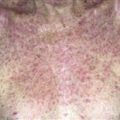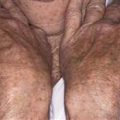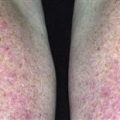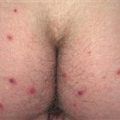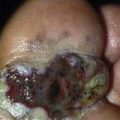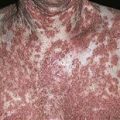25
Chronic urticaria
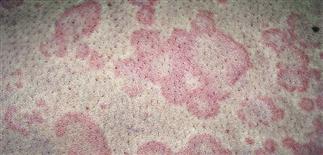
Hives have a variety of patterns. Red, round wheals with a dusky center are a very common presentation. The border is elevated and center is flat.
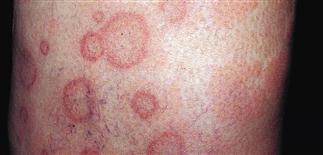
Lesions vary in extent from a few to hundreds of plagues. They can be localized or cover wide areas of the body. They can be sparsely separated or dense and confluent.
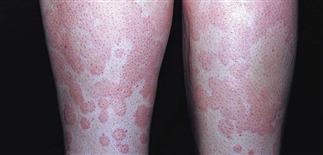
Round plaques have expanded and become confluent. The entire lower leg was swollen, itchy, and painful. Large dense plaques sometimes become dark blue in the centers.
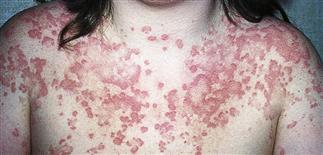
Plaques that last longer than 24 h should be biopsied to exclude the diagnosis of urticarial vasculitis. Urticarial vasculitis lesions are painful rather than itchy.
DESCRIPTION
Non-pitting, edematous plaques called wheals or hives. Hives that last longer than 6 weeks are defined as chronic urticaria. Erythema multiforme may look like wheals (hives). Early bullous pemphigoid may present with urticarial plaques before bullae formation.
HISTORY
Patients sometimes report that lesions appear at a certain time each day. Most patients are young adults. Cause determined in only few cases. If cause unclear after routine history and physical examination, laboratory tests may be of limited use. Think of the five ‘I’s when trying to find the cause. • Ingestants (common): foods, additives, drugs such as antibiotics or others that are relatively new to the patient. • Inhalants: dust, feather, pollen. • Injectants: drugs, stings, bites. • Infections: bacterial, viral, fungal, parasitic. • Internal diseases: such as chronic infections, thyroid disease, lupus erythematosus.
Individual lesions itch, resolve in less than 24 h. Biopsy painful hives that last longer than 24 h to exclude urticarial vasculitis.
PHYSICAL FINDINGS
• Red, non-pitting edematous plaques (wheals) in various shapes and patterns. Lesions round, oval, annular, or polycyclic. Wheals may coalesce to form very large plaques. Size varies from a few millimeters to greater than 10 cm. • Wheals resolve in less than 24 h. New lesions appear as older ones fading. • Tests to consider: complete blood count, sinus X-rays to evaluate for sinusitis, dental X-rays to evaluate for an occult dental abscess, rapid streptococcal test or pharyngeal culture, Mycoplasma titers, and thyroid-stimulating hormone and thyroid microsomal antibody test for autoimmune thyroid disease.
TREATMENT
• Antihistamines. Hydroxyzine the most effective and reliable. Hydroxyzine 10–25 mg can be administered every 4 h, up to 100 mg every 4 h as needed. Many patients adapt and are not sedated after taking medication for a few days. Others do not tolerate sedation, so use hydroxyzine only in evening and a non-sedating antihistamine during day. • Many patients treated with just non-sedating antihistamines. Non-sedating H1 antihistamines include desloratidine (Clarinex 5 mg q.d.), cetirizine (Zyrtec 5 mg, 10 mg q.d.), and fexofenadine (Allegra 60 mg b.i.d. or 180 mg q.d.). In difficult cases, these may be combined with type 2 (H2) antagonists such as cimetidine 400 mg b.i.d. or ranitidine 150 mg b.i.d. Several non-prescription antihistamines are available. • Oral steroids considered for unresponsive cases. Effect not predictably reliable, but sometimes very effective. • May try empiric antibiotic therapy if occult infection, such as a tooth abscess, suspected. Antibiotics rarely effective.

